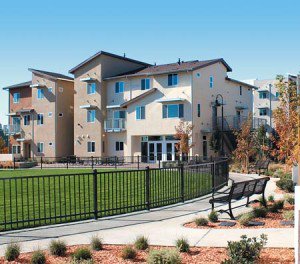By Erica Rascón on September 29, 2014 in People
Michael J. Novogradac, a managing partner at Novogradac & Co., estimates that available affordable housing lags behind demand by as many as 20 million units. The funding simply isn’t there. Without it, low-income families and affordable housing providers are running low on options.
low on options.
Aubrey Fakalata, Resident Manager of Yardi client Burbank Housing has experienced the dire need for new construction firsthand, “That was one of the reasons why [Burbank Housing] built Logan Place (pictured, right), was for the homeless. When the company advertised that they were opening a brand new affordable housing property, they went straight to the homeless shelters. A majority of our applicants were from the shelters throughout Sonoma County,” she says.
Without adequate housing availability, low-income families are relegated to shelters or the streets. Competition for one of the few affordable housing units becomes desperate.
There are several factors contributing to the decline in available housing. Primarily, the building costs have increased while equity has remained the same for decades. There are also fewer gap financing offers and tax credits, with less money flowing from HUD in programs such as the HOME Investment Partnerships and The Community Development Block Grant. Lastly, equity investors aren’t seeing the returns that they would prefer, making affordable housing an unappealing option.
“There is always a shortage of federal and state tax credits to go around,” begins Jeanne Taylor, CFO of Preservation of Affordable Housing, a Yardi client. “After the economy hit a few years ago, the tax credit arena wasn’t as plentiful…and the investors became a little stricter in their requirements.”
Future tax reform could further tighten investors’ purse strings. Any legislation that includes lower rates and longer depreciation would damage the industry’s bottom line. Novogradac & Co. proposes that the industry would see as much as 12 percent less equity, which is about $1 billion each year.
With so many hurdles to new construction, affordable housing providers are taking advantage HUD 811 and 202 properties or setting their sights on the new tax credits and subsidies being issued for the preservation of existing housing. Aptly named Preservation of Affordable Housing has focused its objectives on improving existing properties.
“We’re also looking into what they’re referring to as Rental Assistance Demonstration (RAD), where public housing agencies are going to be transferring to affordable entities and taking over some of the public housing stock that is at-risk, that needs a facelift and a little TLC. We’re touching in that sector as well,” says Taylor.
The new approaches help but they cannot fill the void caused by a lack of new construction. The backlog for existing housing is too great and the demand continues to rise.
“You know, Logan Place is a stepping stone for people who are coming out of the shelter,” explains Fakalata. “[Residents] have a low rent that they would be paying to help them save, to move on to something that’s bigger and better. Logan Place isn’t supposed to be somewhere where they sit forever. They need to use it as a stepping stone to, you know, get out there.” Fakalata shakes her head. “Provide for your family. Put a roof over their heads so that they don’t go back to being homeless again. They can use it as a stepping stone to get a house, get a job, build your rent and landlord history and move on so that they next homeless person can come in and start their new life.”
But that transition isn’t happening fast enough.


